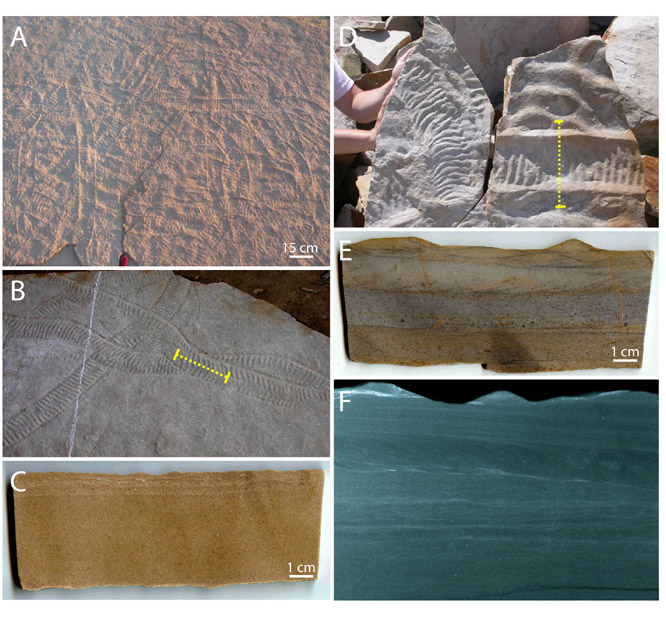

43720-GB8
Influence of Horizontally-Oriented Bioturbation and Microbial Communities on Marginal Marine Sandstones
Microbial
communities and horizontally burrowing organisms exert a strong influence on
ancient sand-dominated environments, yet we do not know what effects such
phenomena have on the fabric of ancient sandstones. This knowledge gap is particularly acute in
many early Paleozoic and Neoproterozoic marginal marine settings, where
microbial mats and horizontal burrowers are the dominant biological influence
on sedimentology. Strata representing
these environments comprise a significant portion of Proterozoic and Paleozoic
hydrocarbon reservoir rocks, particularly in
To address these knowledge gaps, quartz arenites from the Late Cambrian Elk Mound and Potsdam Groups of North America were analyzed as a case study. Strata from these units contain abundant microbially bound sand and horizontal bioturbation, and can be placed in a detailed paleoenvironmental context. Representative results from analysis of the microfabric and internal structure of these sandstones is presented in Figs. 1 and 2 below.
Microbially bound sandstones: After some failed analyses of microbial structures such as sand chips and broached ripples, my students and I focused on sand stromatolites (Fig. 1A,D), which are low-relief domal buildups that are produced by microbial agglutination coupled with trapping and binding of sand. Serially sectioned sand stromatolites were examined for variations in fabric, composition, and porosity using both standard reflected light microscopy, petrography, and X-radiography. Internal laminations or changes in microfabric were not visible within or across stromatolite cores.
Horizontally bioturbated sandstones: Horizontal bioturbation analyses focused on macroscale trace fossils which occur both on intensely bioturbated surfaces (Fig. 2A) as well as in isolated patches (Fig. 2B, D); the latter allowed analysis of adjacent and lithologically similar bioturbated and nonbioturbated bed surfaces. Preliminary results from this work are equivocal; whereas horizontal bioturbation can significantly alter primary sediment fabric, it is difficult to recognize in cross-section (e.g., Fig. 2C) and in compositionally homogeneous sediments does little to change grain packing or sorting. In more clay- and silt-rich wackestones, however, horizontal bioturbation is straightforward to recognize and does significantly alter sediment fabric.
In conducting this research, my students and I have come to realize that although the fabric of quartz arenites are clearly influenced by microbes and bioturbation, such rocks are often silica-cemented and have diagenetic and compactional changes to their fabric (and hence, permeability) that may overprint microbial and bioturbation signals. This made quantitative analysis of microbe- and bioturbation-caused changes in porespace very difficult to assess. Thus, one outcome of this work has been that we have shifted focus somewhat, and are conducting some preliminary experimental work using microbes and unconsolidated sediment. By conducting experiments on unconsolidated sediments using living microbes and horizontally burrowing animals, it is possible that we will be better equipped to quantify how and to what extent cyanobacteria and burrowing affect sediment porosity. Using this experimental approach, future work could impregnate sediments with silica epoxy and/or experimentally compact sediment cores in the lab, thus providing a more direct linkage to understanding how microbial and burrowing processes affect the fabric and permeability of sandstones.
Fig. 2. Representative examples of horizontally bioturbated quartz arenites
(A-C) and quartz-rich wackestones (D-F), including one example (A) which is
intensely bioturbated. All samples bear the trackway Climactichnites, made by the bulldozing
activities of a large slug-like mollusk.
In lithologically homogeneous sandstones (B-C), fabric disruptions due
to bioturbation are not visible in polished slabs (C), X-radiographs, or
photomicrographs. In muddier sandstones
(D-F), burrowed horizons are clearly visible as unlaminated or homogenized
zones visible in polished slab (E) and X-radiograph (F) views. A-C: Elk Mound 
Fig. 1. Internal structure and microfabric of sand stromatolites, Elk Mound
Gp, WI (A-C), and Potsdam Gp, NY-QUE-ONT (D-F). Upper images are plan
views of bed surfaces; note isolated domal sand buildups indicated by dashed
lines. Polished slab views (B, E),
X-radiographic views (C, F), and photomicrographs (not pictured) illustrate no internal
structure, lamination, or variations in porosity akin to those observed in
carbonate-hosted stromatolites or laminites.
